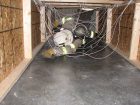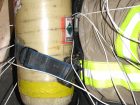
Back to basics July 2017: Making a mayday call
By Mark van der Feyst
Features Fire Ground Training annex Canada firefighter trainingIn the last few issues, we have built a foundation of key firefighter survival skills and an understanding of the importance of having these skills. We will now build upon that foundation with some integral survival strategies, beginning with mayday calls.
A mayday call is a distress signal that originated in 1923 in the aviation industry. Since then, the mayday call has been integrated into a variety of operations that use radio communication – including the fire service. The term mayday, derived from the French “m’aider” (help me), is to be used only in a life-threatening emergency situation.
The call is always made three times in a row: “mayday, mayday, mayday.”
The mayday call can be used by personnel who are trapped, in imminent danger or in need of immediate assistance. The call can also be used by the incident commander (IC) if a firefighter is missing: this should be used only in emergencies, so that when crews hear a mayday call they know a firefighter needs immediate help. For all other fire-ground emergencies such as building collapse or water supply problems, the term emergency traffic should be used.
The key to successful mayday calls is getting firefighters to declare them as soon as they recognize they need help. The quicker the mayday is declared, the quicker the rapid intervention team (RIT) or other nearby firefighters can be activated to help. In firefighter survival training, it’s imperative that firefighters recognize that when they face a life-threatening situation (out of air, lost, trapped, injured), they need to call a mayday. Making the call needs to be stressed to both new and seasoned firefighters.
Are you prepared to make the call should you face a life-or-death situation? The obstacle for most firefighters is pride. You are not weak if you make a mayday call. Some colleagues may belittle other firefighters for calling a mayday; this is a shame tactic, designed to make people feel bigger and stronger by putting down others. A mayday is designed to save a life. Firefighters should not be afraid to ask for help and make the call; the only thing calling a mayday says about a firefighter is that he or she wants to live.
Another obstacle to calling a mayday is doubt; firefighters may wonder if they really need help or if they can get themselves out of the situation on their own. If your gut is telling you to call a mayday, then do so. Too often, firefighters doubt the need for help: they figure that they can take care of the problem on their own because after all, they are firefighters, they save lives. However, firefighters are not invincible and sometimes they do need help.
Are you prepared to handle a mayday call?
This question applies to both firefighters and the officers in charge. As a firefighter, when you hear a mayday call come over the radio, how will you to react?
When a mayday is called, firefighters still need to fight the fire, complete searches and advance hose lines. The mayday call does not stop the fire fight and attacking firefighters are not able to focus on the mayday – if they do the overall situation will certainly get worse. Firefighters may want to go and help their friend, but it’s critical to train to stay the course of our assigned duties and until command indicates otherwise.
As an officer in charge of the fire ground, how are you going to handle a mayday call? Are you ready to hand the call off to another fire officer or pass the fire-ground operation to another officer? No fire officer can handle both. The officer will need to pass command of either the mayday call or the fire ground to another officer; doing so will make the officer a more effective commander and will give the distressed firefighter a better chance of survival.
Mark van der Feyst has been in the fire service since 1999 and is a full-time firefighter in Ontario. He teaches in Canada, the United States and India and is lead author of Residential Fire Rescue. Mark@FireStarTraining.com
Print this page
Advertisement
- Stop, talk and console: Five things firefighters should change to maintain good mental health
- The danger within: The importance of tracking firefighter biometrics

